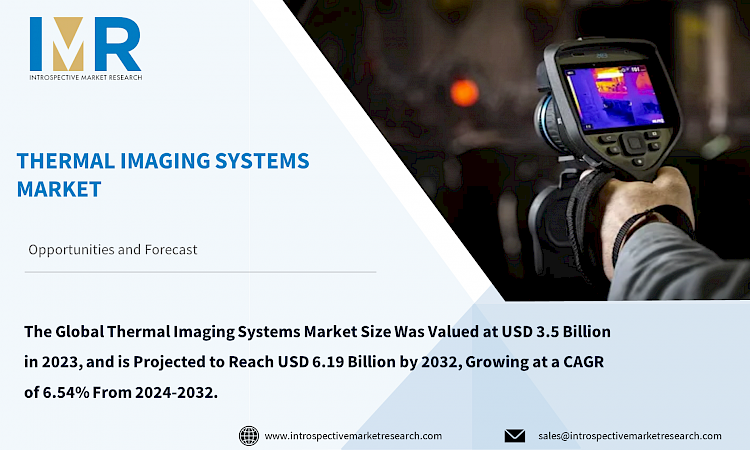
Thermal Imaging Systems Market
According to a new report published by Introspective Market Research, titled, “Thermal Imaging Systems Market by Application and Technology: Global Opportunity Analysis and Industry Forecast, 2024–2032,”
the Global Thermal Imaging Systems Market Size Was Valued at USD 3.5 Billion in 2023, and is Projected to Reach USD 6.19 Billion by 2032, Growing at a CAGR of 6.54% From 2024-2032.
Thermal imaging systems use specialized sensors to detect infrared radiation from objects, generating images that reflect temperature variations. These systems convert thermal energy into visible images, allowing the identification of heat signatures in fields like surveillance, medical diagnostics, and industrial inspections. In surveillance, thermal imaging enhances visibility in low-light conditions and detects intruders based on body heat. In medical diagnostics, it identifies abnormalities in blood flow, inflammation, and other conditions, aiding in early disease detection. Industrially, it detects equipment malfunctions, and overheating components, and optimizes energy efficiency by pinpointing heat loss areas. Thermal imaging provides non-contact, non-invasive temperature measurements, ideal for sensitive environments or delicate subjects. It offers real-time data visualization for immediate analysis and decision-making in situations like firefighting and building inspections. Operating effectively in smoke, fog, or darkness, these systems are valuable in critical situations. As industries focus on efficiency and safety, advancements will make thermal imaging systems more compact, affordable, and widely adopted.
The Thermal Imaging Systems Market is segmented into Product Type, Technology, Application, and region. By Product Type, the market is categorized into Cameras, Scopes, and Modules. By Technology, the market is categorized into Microbolometers, Quantum Well-Infrared Photodetectors (QWIPs), and Uncooled. By Application, the market is categorized into Security & Surveillance, Defense & Military, Industrial, Medical, and Scientific Research.
The rise in thermal imaging technology in defense and military sectors drives market growth, crucial for reconnaissance, surveillance, and target acquisition in low-light and harsh conditions. Advancements have led to portable, lightweight systems in drones, helmets, and weapon sights, enhancing mobility and battlefield awareness. Global security challenges and the need to modernize military equipment fuel demand. Additionally, awareness of thermal imaging benefits in various industries like automotive, healthcare, and agriculture boosts market opportunities, improving safety, efficiency, and cost-effectiveness. Enhanced accessibility and tailored applications drive adoption and innovation in thermal imaging systems across multiple sectors
Global Thermal Imaging Systems Market, Segmentation
Thermal Imaging Systems Market Segmented based on Product Type, Technology, Application, and Region.
Technology:
The Technology segment is further classified into Microbolometers, Quantum Well-Infrared Photodetectors (QWIPs), and Uncooled. Among these, the Microbolometers sub-segment accounted for the highest market share in 2023. The Microbolometers segment is poised to lead the growth of the Thermal Imaging Systems Market. These sensors, known for their exceptional sensitivity to infrared radiation, are essential for capturing precise and accurate thermal images. As industries in defense, automotive, and aerospace increasingly rely on thermal imaging for various applications, the demand for microbolometers is expected to surge. With continuous improvements in resolution, sensitivity, and integration capabilities, microbolometers deliver superior performance compared to other sensor technologies. This has led to their preference among manufacturers and end-users, thereby fueling the expansion of the Thermal Imaging Systems Market and solidifying the microbolometers segment as a key growth driver.
Application:
The application segment is further classified into the Security & Surveillance, Defense & Military, Industrial, Medical, Scientific Research. Among these, the Defense & Military sub-segment is anticipated to show the fastest growth by 2032. The primary driver behind the growth of the Thermal Imaging Systems Market is the Defense & Military segment. Known for its rigorous requirements for advanced surveillance and target acquisition capabilities, this sector has significantly fueled the demand for thermal imaging technology. With a growing emphasis on modernizing military equipment and enhancing situational awareness, defense and military organizations globally have heavily invested in thermal imaging systems for reconnaissance, surveillance, and threat detection. The prominence of the Defense & Military segment in the Thermal Imaging Systems Market underscores the essential role of thermal imaging technology in bolstering national security and defense capabilities worldwide, driving continuous innovation and advancements in the field.
Region:
The Thermal Imaging Systems market in North America is projected to show the fastest growth by 2032. North America is poised to lead the expansion of the Thermal Imaging Systems market. The region's strong presence of major market players, technological innovators, and a substantial defense budget underscores its keen interest in adopting advanced thermal imaging solutions. The increasing deployment of these systems across sectors such as defense, aerospace, automotive, and industrial applications further propels market growth in North America.
Some of The Leading/Active Market Players Are-
- Flir Systems Inc. (U.S.)
- Fluke Corporation (U.S.)
- Leonardo DRS (U.S.)
- Testo Inc. (U.S.)
- United Technologies (U.S.)
- Teledyne FLIR LLC (U.S.)
- L3Harris Technologies, Inc (U.S.)
- Seek Thermal Inc. (U.S.)
- Trijicon Inc. (U.S.)
- Raytheon Co. (U.S.) and Other Active Players
Key Industry Developments
- In February 2024, Motorola Solutions announced on Wednesday that it had acquired the UK-based thermal camera company Silent Sentinel to enhance its video security capabilities in locations such as airports and oil and gas facilities. According to Mahesh Saptharishi, the U.S. company's chief technology officer, Silent Sentinel demonstrated significant expertise in thermographic imaging. Their cameras are capable of detecting anomalies from distances of up to 30 kilometers.
- In August 2023, Silicon-based photonics company SIONYX recently acquired American Imaging Engineering (Amigen), a leading provider of thermal imaging systems. This acquisition aimed to expand the possibilities within the imaging technology and night vision markets. The founder and President of Amigen, Jeffrey Lee, joined SIONYX as the Chief Technology Officer of its commercial products division.
Key Findings of the Study
- Defense & Military segment held the largest share of 42.8% in 2023, in Application Segment.
- The North American region is expected to continue to lead the market followed by North America during the forecast period.
- the Global Thermal Imaging Systems Market Size Was Valued at USD 3.5 Billion in 2023 and is Projected to Reach USD 6.19 Billion by 2032, Growing at a CAGR of 6.54% From 2024-2032.






